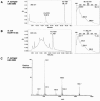Yersiniabactin production by Pseudomonas syringae and Escherichia coli, and description of a second yersiniabactin locus evolutionary group
- PMID: 16751485
- PMCID: PMC1489633
- DOI: 10.1128/AEM.00119-06
Yersiniabactin production by Pseudomonas syringae and Escherichia coli, and description of a second yersiniabactin locus evolutionary group
Abstract
The siderophore and virulence factor yersiniabactin is produced by Pseudomonas syringae. Yersiniabactin was originally detected by high-pressure liquid chromatography (HPLC); commonly used PCR tests proved ineffective. Yersiniabactin production in P. syringae correlated with the possession of irp1 located in a predicted yersiniabactin locus. Three similarly divergent yersiniabactin locus groups were determined: the Yersinia pestis group, the P. syringae group, and the Photorhabdus luminescens group; yersiniabactin locus organization is similar in P. syringae and P. luminescens. In P. syringae pv. tomato DC3000, the locus has a high GC content (63.4% compared with 58.4% for the chromosome and 60.1% and 60.7% for adjacent regions) but it lacks high-pathogenicity-island features, such as the insertion in a tRNA locus, the integrase, and insertion sequence elements. In P. syringae pv. tomato DC3000 and pv. phaseolicola 1448A, the locus lies between homologues of Psyr_2284 and Psyr_2285 of P. syringae pv. syringae B728a, which lacks the locus. Among tested pseudomonads, a PCR test specific to two yersiniabactin locus groups detected a locus in genospecies 3, 7, and 8 of P. syringae, and DNA hybridization within P. syringae also detected a locus in the pathovars phaseolicola and glycinea. The PCR and HPLC methods enabled analysis of nonpathogenic Escherichia coli. HPLC-proven yersiniabactin-producing E. coli lacked modifications found in irp1 and irp2 in the human pathogen CFT073, and it is not clear whether CFT073 produces yersiniabactin. The study provides clues about the evolution and dispersion of yersiniabactin genes. It describes methods to detect and study yersiniabactin producers, even where genes have evolved.
Figures







Similar articles
-
Salicylic acid, yersiniabactin, and pyoverdin production by the model phytopathogen Pseudomonas syringae pv. tomato DC3000: synthesis, regulation, and impact on tomato and Arabidopsis host plants.J Bacteriol. 2007 Oct;189(19):6773-86. doi: 10.1128/JB.00827-07. Epub 2007 Jul 27. J Bacteriol. 2007. PMID: 17660289 Free PMC article.
-
Characterization of pyoverdine and achromobactin in Pseudomonas syringae pv. phaseolicola 1448a.BMC Microbiol. 2011 Oct 3;11:218. doi: 10.1186/1471-2180-11-218. BMC Microbiol. 2011. PMID: 21967163 Free PMC article.
-
Comparison of the complete genome sequences of Pseudomonas syringae pv. syringae B728a and pv. tomato DC3000.Proc Natl Acad Sci U S A. 2005 Aug 2;102(31):11064-9. doi: 10.1073/pnas.0504930102. Epub 2005 Jul 25. Proc Natl Acad Sci U S A. 2005. PMID: 16043691 Free PMC article.
-
Closing the circle on the discovery of genes encoding Hrp regulon members and type III secretion system effectors in the genomes of three model Pseudomonas syringae strains.Mol Plant Microbe Interact. 2006 Nov;19(11):1151-8. doi: 10.1094/MPMI-19-1151. Mol Plant Microbe Interact. 2006. PMID: 17073298 Review.
-
Roadmap to new virulence determinants in Pseudomonas syringae: insights from comparative genomics and genome organization.Mol Plant Microbe Interact. 2008 Jun;21(6):685-700. doi: 10.1094/MPMI-21-6-0685. Mol Plant Microbe Interact. 2008. PMID: 18624633 Review.
Cited by
-
Siderophores in environmental research: roles and applications.Microb Biotechnol. 2014 May;7(3):196-208. doi: 10.1111/1751-7915.12117. Epub 2014 Feb 27. Microb Biotechnol. 2014. PMID: 24576157 Free PMC article. Review.
-
Salicylic acid, yersiniabactin, and pyoverdin production by the model phytopathogen Pseudomonas syringae pv. tomato DC3000: synthesis, regulation, and impact on tomato and Arabidopsis host plants.J Bacteriol. 2007 Oct;189(19):6773-86. doi: 10.1128/JB.00827-07. Epub 2007 Jul 27. J Bacteriol. 2007. PMID: 17660289 Free PMC article.
-
Development of SCAR markers for rapid and specific detection of Pseudomonas syringae pv. morsprunorum races 1 and 2, using conventional and real-time PCR.Appl Microbiol Biotechnol. 2016 Apr;100(8):3693-711. doi: 10.1007/s00253-016-7295-0. Epub 2016 Feb 1. Appl Microbiol Biotechnol. 2016. PMID: 26830104 Free PMC article.
-
Mining for Nonribosomal Peptide Synthetase and Polyketide Synthase Genes Revealed a High Level of Diversity in the Sphagnum Bog Metagenome.Appl Environ Microbiol. 2015 Aug;81(15):5064-72. doi: 10.1128/AEM.00631-15. Epub 2015 May 22. Appl Environ Microbiol. 2015. PMID: 26002894 Free PMC article.
-
Wide Distribution of Foxicin Biosynthetic Gene Clusters in Streptomyces Strains - An Unusual Secondary Metabolite with Various Properties.Front Microbiol. 2017 Feb 21;8:221. doi: 10.3389/fmicb.2017.00221. eCollection 2017. Front Microbiol. 2017. PMID: 28270798 Free PMC article.
References
-
- Ausubel, F. M., R. Brent, R. E. Kingston, D. D. Moore, J. G. Seidlan, J. A. Smith, and K. Struhl. 2000. Current protocols in molecular biology. John Wiley & Sons, Inc., New York, N.Y.
-
- Bach, S., A. de Almeida, and E. Carniel. 2000. The Yersinia high-pathogenicity island is present in different members of the family Enterobacteriaceae. FEMS Microbiol. Lett. 183:289-294. - PubMed
Publication types
MeSH terms
Substances
LinkOut - more resources
Full Text Sources
Other Literature Sources
Molecular Biology Databases
Miscellaneous

